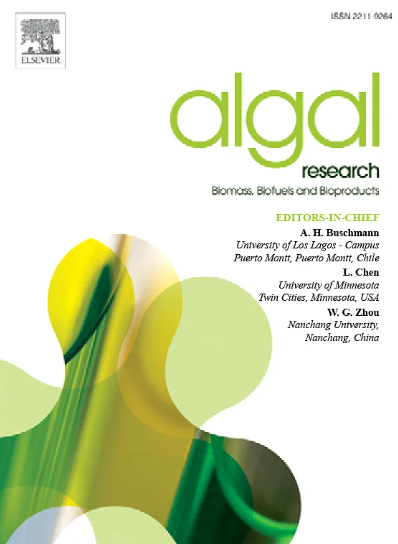Effects of cultivar selection, cultivation region and harvest timing on the structure and properties of carbohydrates from Saccharina japonica
IF 4.5
2区 生物学
Q1 BIOTECHNOLOGY & APPLIED MICROBIOLOGY
Algal Research-Biomass Biofuels and Bioproducts
Pub Date : 2025-05-19
DOI:10.1016/j.algal.2025.104106
引用次数: 0
Abstract
The study aimed to explore the difference of yields, structures, and functions of three carbohydrates in Saccharina japonica (S. japonica), considering the differences of cultivars of Haiza (the northern cultivar) and Puke (the southern cultivar), cultivation regions (the north, the south, and the transplanted Puke from south to north), and harvesting times during their whole cultivation. The yield of mannitol was significantly higher in samples cultivated in the north region (5.07–27.82 %) compared to those from the south (2.34–3.37 %), and for both cultivars the optimal yield was in May and June. The molecular weight of alginate was lower in Puke but higher in both Haiza and the transplanted Puke. The mannuronate/guluronate ratio of alginate noticeably deceased from levels of 2.28–2.40 to levels of 1.68–1.93 after transplantation Puke from the south to north, which indicated the possible upregulation of the expression of genes encoding mannuronate C5-epimerases in colder temperature cultivation. Meanwhile, different fucoidan samples showed diverse monosaccharide composition, sulfate content, sulfation positions, and antioxidant activities. Fucoidans from Haiza showed better ABTS and hydroxyl radical scavenging ability. The correlation analysis indicated that the fucose content was positively correlated with ABTS radical scavenging ability (R = 0.576), while fucose and sulfate group contents were negatively correlated with the hydroxyl radical scavenging ability (R = 0.581 and R = 0.829). Overall, this study deepened the understanding of carbohydrates diversity in S. japonica and provided a scientific foundation for optimizing its cultivation strategies.

品种选择、栽培区域和采收时机对粳稻碳水化合物结构和性质的影响
本研究旨在探讨三种碳水化合物在粳稻(Saccharina japonica, S. japonica)产量、结构和功能上的差异,同时考虑北方品种“海扎”(Haiza)和南方品种“普克”(Puke)、栽培区域(北、南、从南到北移植的普克)和整个栽培过程中收获时间的差异。甘露醇在北方地区的产量(5.07 - 27.82%)显著高于南方地区(2.34 - 3.37%),两种品种的最佳产量均在5月和6月。海藻酸盐的分子量在呕吐物中较低,在海扎和移栽呕吐物中较高。移植Puke后,甘露酸盐/ gulur酸盐比值从2.28 ~ 2.40显著降低至1.68 ~ 1.93,说明甘露酸盐c5 -外膜酶编码基因可能在低温培养中表达上调。同时,不同岩藻聚糖样品的单糖组成、硫酸根含量、硫酸根位置和抗氧化活性均存在差异。海扎岩藻胶具有较好的ABTS和羟基自由基清除能力。相关性分析表明,focus含量与ABTS自由基清除能力呈正相关(R = 0.576),而focus和硫酸盐基团含量与羟基自由基清除能力呈负相关(R = 0.581和R = 0.829)。本研究加深了对粳稻碳水化合物多样性的认识,为优化粳稻栽培策略提供了科学依据。
本文章由计算机程序翻译,如有差异,请以英文原文为准。
求助全文
约1分钟内获得全文
求助全文
来源期刊

Algal Research-Biomass Biofuels and Bioproducts
BIOTECHNOLOGY & APPLIED MICROBIOLOGY-
CiteScore
9.40
自引率
7.80%
发文量
332
期刊介绍:
Algal Research is an international phycology journal covering all areas of emerging technologies in algae biology, biomass production, cultivation, harvesting, extraction, bioproducts, biorefinery, engineering, and econometrics. Algae is defined to include cyanobacteria, microalgae, and protists and symbionts of interest in biotechnology. The journal publishes original research and reviews for the following scope: algal biology, including but not exclusive to: phylogeny, biodiversity, molecular traits, metabolic regulation, and genetic engineering, algal cultivation, e.g. phototrophic systems, heterotrophic systems, and mixotrophic systems, algal harvesting and extraction systems, biotechnology to convert algal biomass and components into biofuels and bioproducts, e.g., nutraceuticals, pharmaceuticals, animal feed, plastics, etc. algal products and their economic assessment
 求助内容:
求助内容: 应助结果提醒方式:
应助结果提醒方式:


